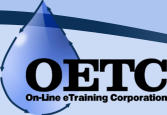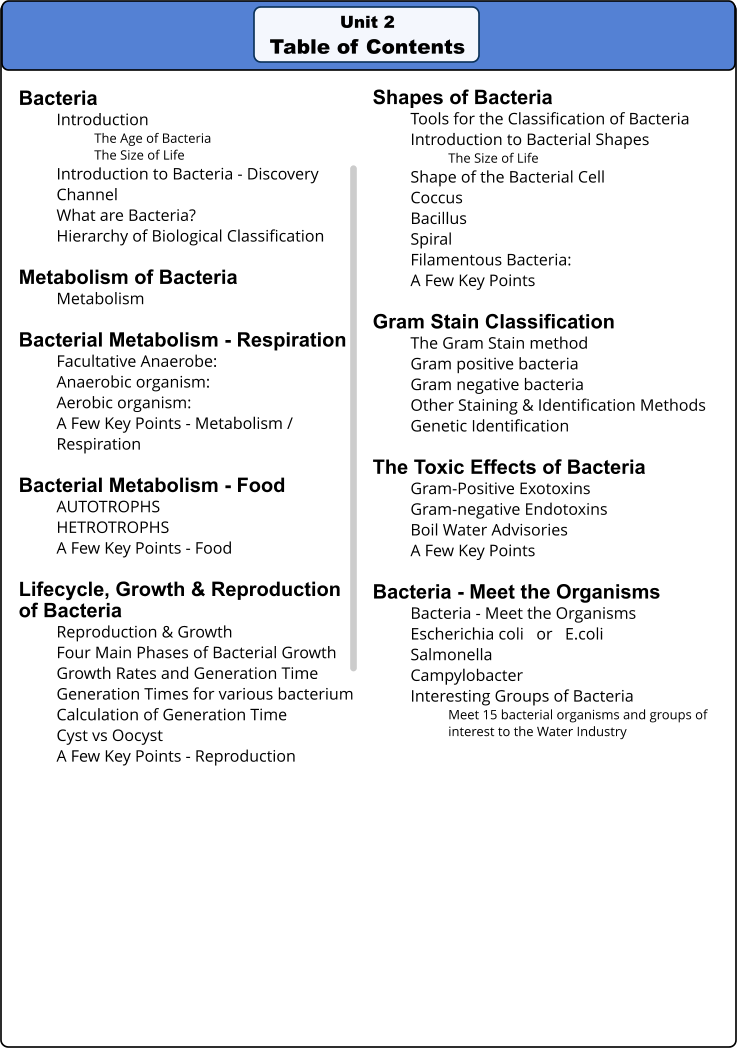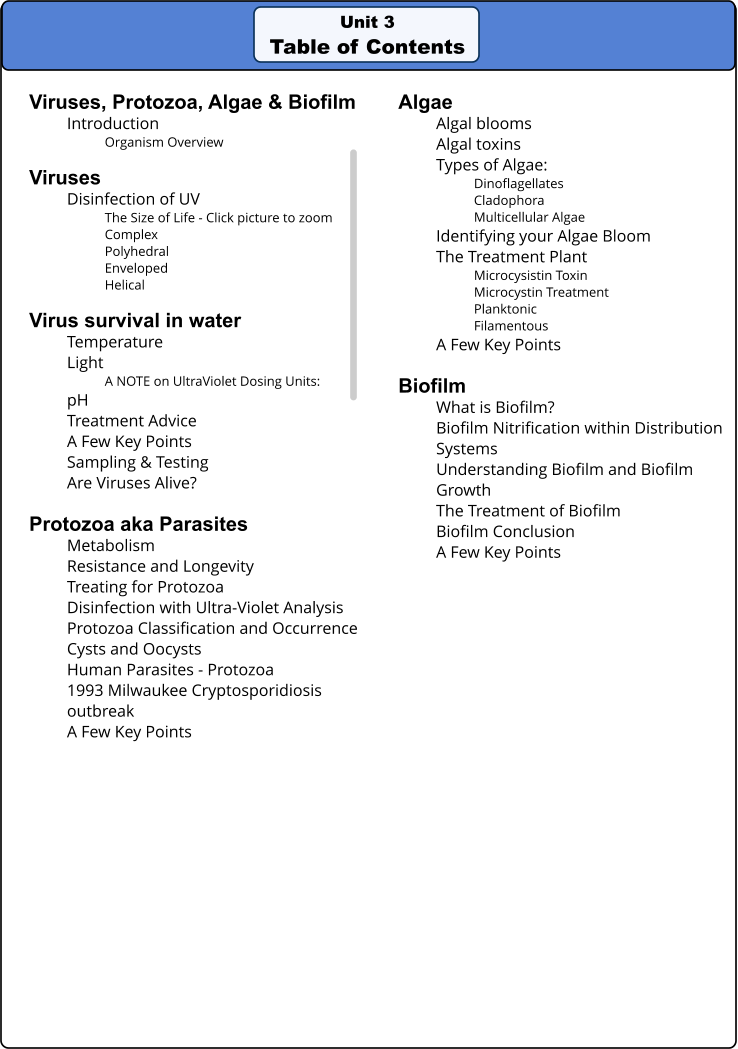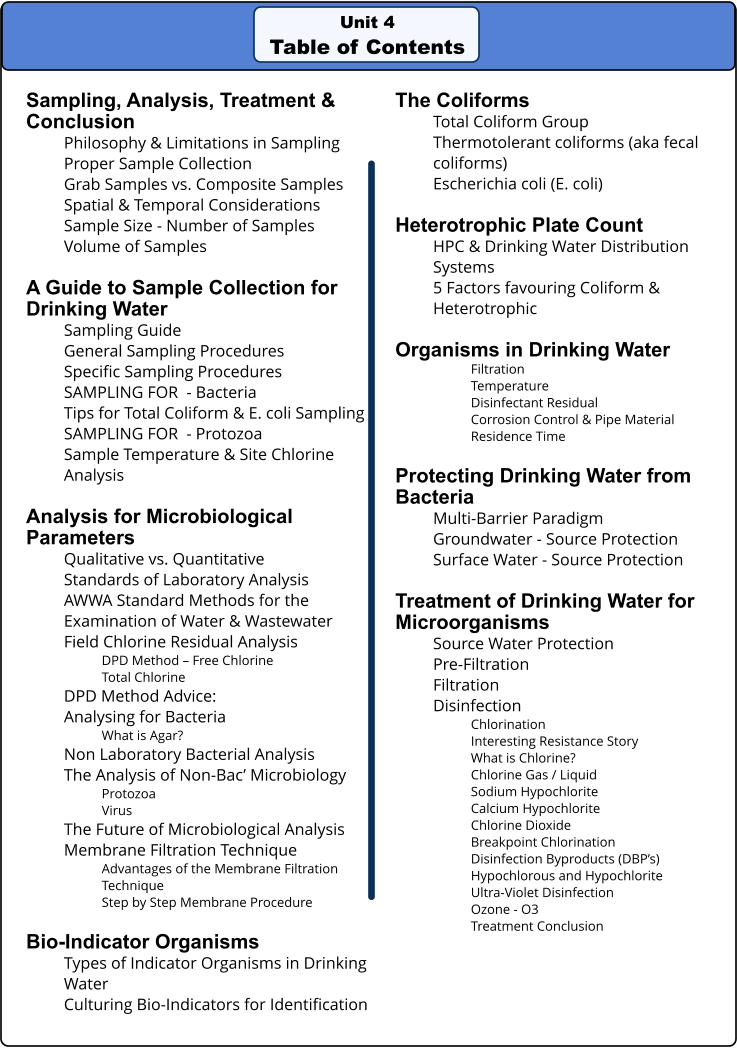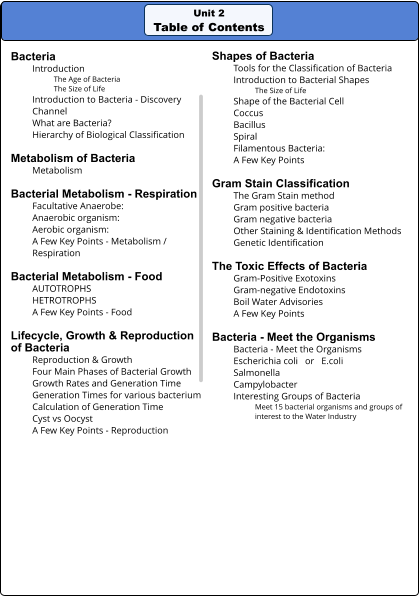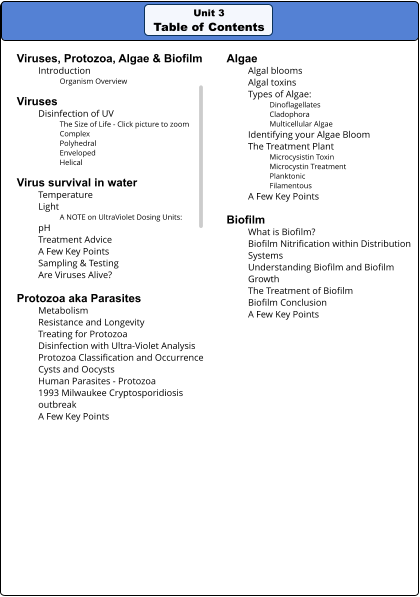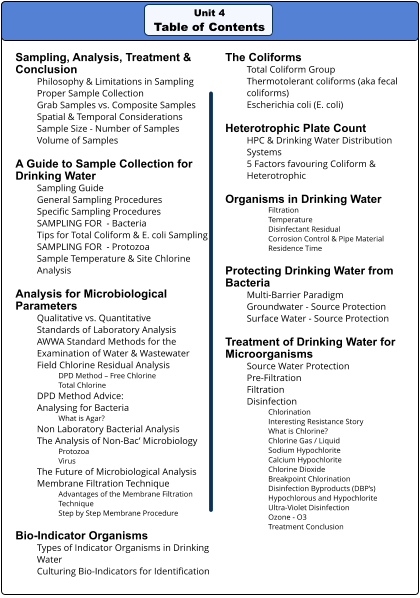Microbiology for Water Operations
In this course, we will look at all of the micro-organisms of interest to the Water professional. This course was developed for the drinking
water treatment & distribution operator, lab technician, engineering professional, manager & director, politician, maintenance and SCADA
technician, constructor/contractor, regulator/inspector or anyone who works within the drinking water industry. Even wastewater Treatment
and collection personnel will gain valuable knowledge from this course.
We’ll start with an overview of threats, mitigation and contamination history then proceed with a brief refresher of chemistry and biology.
This overview will provide a truncated, fat trimmed, Coles notes version of both of these imminence subjects. You’ll wish you had these
overviews in high school and college.
We go from the origin of the elements, through the structure of atoms, winding around a scientific view of water, dipping into acids and
bases before coming up into a summation and introduction to organic chemistry. Understanding the rules and properties of inanimate stuff
will help us understand the study of the animate stuff. This leads us into the subject of biology where we start at an explanation of
evolution and wind through the classification and naming structure of biology while we fly over cell types and land with a summation of the
energy or spark of life.
We’ll learn about bacteria, what they are, how they feed, reproduce and how they make us sick. We’ll gain an understanding of how they
are named, what shapes they come in and how we analyse for them. Before leaving the focused view of bacteria, we’ll review a number
of specific species and groups, 15 in total. These will include: E.coli, Salmonella, Campylobacter, Cholera as well as groups like iron
bacteria and the nitrifiers.
From bacteria, we move into viruses, protozoa and algae. Following an introduction we will look at each microb of interest to the drinking
water industry within that group. We’ll cover proper sampling techniques, the process of how various types of Microbiological tests are
conducted and a whole lot more. Take a look at the truncated tables of contents below.
All the information in this course is in layman’s terms. We’re not going to teach the internal structures of cells or make you memorize long
words or dates you’ll never use again. You will be provided pure, usable information with no (or at least very little) fluff.
For your Due Diligence, for your knowledge in your chosen profession, for the safety of our communities, every employee in the service of
the public water supply needs to know what this course teaches. Whether you’re an operator of 30yrs experience or 3 months, we
guarantee you will learn things you never knew but need to know.
Director Approved in Ontario (1.8 CEU’s) - Course Code 14376
Microbiology for Water Operations - $795.
00
(online - 1yr to complete)
On-Line Course - $795 - Taxes Extra- 1yr to Complete
OETC Home
Split Screen Instruction
Course Store - eCourses - FAQ - Login
Browser Troubleshooting - Contact us - Newsletter - Invoice Set-up
Terms & Conditions - Privacy Policy - Certificate Verification - Cheater Report - Operator Resources
© Copyright OETC Inc. 2005-2025 - All Rights Reserved
Unit 1
Table of Contents

Legal Disclaimer
Zoom
Introduction to e-Training
Quizzes
• Quizzes are Open Book
• Quiz Questions and Layout
Toolbar
Legend
Cheating
A Look at Memory Retention
Don’t Skip this!
Conclusion
Introduction to Microbiology for
Water Operations
Planktonic Algae
Filamentous Algae
What Were Going to Cover
A Brief History of Water Contamination
Multi-Barrier Paradigm
A Discussion on Risk
Infrastructure Risks
A Few Key Points
Introduction to Chemistry
Atoms and Molecules
Periodic Table of the Elements
Atomic Structure
Valance Electrons
Four Atomic Bonds
1 - Ionic bonding
2 - Covalent bonding
3 - Polar Bonding
4 - Hydrogen Bonding
Structure of H2O
The Unique Properties of Water
1 - Density of Water
2 - Phases of Water and the Triple Point
3 - Light & Sound & Electromagnetic
Absorption
4 - Specific Heat Capacity & Heat of
Vaporization
5 - Surface Tension and Capillary Action
Acids, Bases and pH
pH = -log[H+]
Buffers
Conjugate Acid-Base Pairs
Organic Chemistry - A Brief
Introduction
1 - Hydrocarbons
2 - Functional Groups
3 - Nomenclature & Structural Drawings
4 - Lipids (aka Fats)
Introduction to Biology
What is Life?
Evolution - What is it?
Classification of Life - Taxonomy
Two Empire System
YOU are a
Eukaryote!
Prokaryote vs Eukaryote
Two Empire System of Classification
Three Domains of Life
1 - Archaea
2 - Bacteria
3 - Eukaryotes
Three Domain System of Classification
Cellular Energy
ATP - ADP


Microbiology for Water Operations
Delivered through a Unit Webpages and intelligent quizzing
Everything required is included on-line.
There is no manual for this course.
Enroll today, Complete today or take 1-year to complete from enrollment date, CEU’s registered with regulator within 72hrs
Course Developed and Delivered by Vaughan Martin This course has met the requirements under O. Reg. 128/04 as Director Approved Continuing Education.Covered in this Course


Technical Guidance &
Drinking Water-Wastewater
Science
Microbiology for Water Operations
In this course, we will look at all of the micro-organisms of interest to the
Water professional. This course was developed for the drinking water
treatment & distribution operator, lab technician, engineering professional,
manager & director, politician, maintenance and SCADA technician,
constructor/contractor, regulator/inspector or anyone who works within the
drinking water industry. Even wastewater Treatment and collection
personnel will gain valuable knowledge from this course.
We’ll start with an overview of threats, mitigation and contamination history
then proceed with a brief refresher of chemistry and biology. This overview
will provide a truncated, fat trimmed, Coles notes version of both of these
imminence subjects. You’ll wish you had these overviews in high school and
college.
We go from the origin of the elements, through the structure of atoms,
winding around a scientific view of water, dipping into acids and bases
before coming up into a summation and introduction to organic chemistry.
Understanding the rules and properties of inanimate stuff will help us
understand the study of the animate stuff. This leads us into the subject of
biology where we start at an explanation of evolution and wind through the
classification and naming structure of biology while we fly over cell types
and land with a summation of the energy or spark of life.
We’ll learn about bacteria, what they are, how they feed, reproduce and
how they make us sick. We’ll gain an understanding of how they are named,
what shapes they come in and how we analyse for them. Before leaving the
focused view of bacteria, we’ll review a number of specific species and
groups, 15 in total. These will include: E.coli, Salmonella, Campylobacter,
Cholera as well as groups like iron bacteria and the nitrifiers.
From bacteria, we move into viruses, protozoa and algae. Following an
introduction we will look at each microb of interest to the drinking water
industry within that group. We’ll cover proper sampling techniques, the
process of how various types of Microbiological tests are conducted and a
whole lot more. Take a look at the truncated tables of contents below.
All the information in this course is in layman’s terms. We’re not going to
teach the internal structures of cells or make you memorize long words or
dates you’ll never use again. You will be provided pure, usable information
with no (or at least very little) fluff.
For your Due Diligence, for your knowledge in your chosen profession, for
the safety of our communities, every employee in the service of the public
water supply needs to know what this course teaches. Whether you’re an
operator of 30yrs experience or 3 months, we guarantee you will learn
things you never knew but need to know.
Director Approved in Ontario (1.8 CEU’s) - Course Code 14376
Microbiology for Water Operations - $795.
00
(online - 1yr to
complete)
On-Line Course - $795 - Taxes Extra- 1yr to Complete
OETC Home
Split Screen Instruction
Course Store - eCourses - FAQ - Login
Browser Troubleshooting - Contact us - Newsletter - Invoice Set-up
Terms & Conditions - Privacy Policy - Certificate Verification - Cheater Report
Operator Resources
© Copyright OETC Inc. 2005-2025 - All Rights Reserved
Unit 1
Table of Contents

Legal Disclaimer
Zoom
Introduction to e-Training
Quizzes
• Quizzes are Open Book
• Quiz Questions and Layout
Toolbar
Legend
Cheating
A Look at Memory Retention
Don’t Skip this!
Conclusion
Introduction to Microbiology for
Water Operations
Planktonic Algae
Filamentous Algae
What Were Going to Cover
A Brief History of Water Contamination
Multi-Barrier Paradigm
A Discussion on Risk
Infrastructure Risks
A Few Key Points
Introduction to Chemistry
Atoms and Molecules
Periodic Table of the Elements
Atomic Structure
Valance Electrons
Four Atomic Bonds
1 - Ionic bonding
2 - Covalent bonding
3 - Polar Bonding
4 - Hydrogen Bonding
Structure of H2O
The Unique Properties of Water
1 - Density of Water
2 - Phases of Water and the Triple Point
3 - Light & Sound & Electromagnetic
Absorption
4 - Specific Heat Capacity & Heat of
Vaporization
5 - Surface Tension and Capillary Action
Acids, Bases and pH
pH = -log[H+]
Buffers
Conjugate Acid-Base Pairs
Organic Chemistry - A Brief
Introduction
1 - Hydrocarbons
2 - Functional Groups
3 - Nomenclature & Structural Drawings
4 - Lipids (aka Fats)
Introduction to Biology
What is Life?
Evolution - What is it?
Classification of Life - Taxonomy
Two Empire System
YOU are a
Eukaryote!
Prokaryote vs Eukaryote
Two Empire System of Classification
Three Domains of Life
1 - Archaea
2 - Bacteria
3 - Eukaryotes
Three Domain System of Classification
Cellular Energy
ATP - ADP


Microbiology for Water Operations
Delivered through a Unit Webpages and intelligent quizzing
Everything required is included on-line.
There is no manual for this course.
Enroll today, Complete today or take 1-year to complete from
enrollment date, CEU’s registered with regulator within 72hrs
Course Developed and Delivered by Vaughan Martin This course has met the requirements under O. Reg. 128/04 as Director Approved Continuing Education.Covered in this Course


